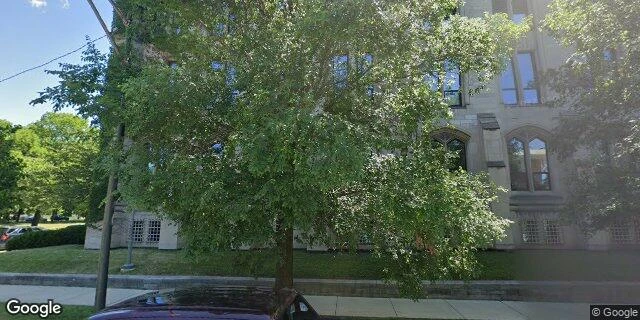
Attribution: © Google 2025
Building Info
- Square Footage
- 65,745 sqftLower than 86% of all buildings1/2 median139,707 sqft0.5x median College/University119,629 sqft
- Built
- 1938
- Primary Property Type
- College/University
- Community Area
- Woodlawn
- Ward
- 5
-
Chicago Energy Rating
- 1.0 / 4
- Owner

Note: Owner manually tagged. Logo used under fair use.
2022 Report Card
Debug Full Grade Data
- AvgPercentileLetterGrade: D
- AvgPercentileGrade: 30.78850881620293
- GHGIntensityLetterGrade: F
- GHGIntensityPercentileGrade: 5.529411764705884
- EnergyMixLetterGrade: C
- EnergyMixWeightedPctSum: 22.244351235335643
- EnergyMixPercentileGrade: 45.05950733462497
- SubmittedRecordsLetterGrade: A
- MissingRecordsCount: 0.0
- SubmittedRecordsPercentileGrade: 100.0
Emissions & Energy Information for 2022
- Greenhouse Gas Intensity F
- 14.5 kg CO2e / sqft#7 Highest of College/Universities 🚨Higher than 94% of all buildings2.3x median6.4 kg CO2e / sqft1.7x median College/University8.4 kg CO2e / sqft
- Total Greenhouse Gas Emissions
- 951.3 tons CO2eHigher than 53% of all buildings1.1x median885.8 tons CO2e1.0x median College/University952.6 tons CO2e
Years Reported
8/8
A

2015
2016
2017
2018
2019
2020
2021
2022
Energy Breakdown
- Fossil Gas Use (aka Natural Gas)
- 0 kBtu#5 Lowest of College/Universities 🏆Lower than 97% of all buildingsMedian Chicago Building5,818,399.6 kBtuMedian College/University4,847,201 kBtuThis Building Uses District Heating ❗
Although this building didn't burn any fossil gas on site, it's connected to a district heating system, a centralized system for heating multiple buildings. District heating systems can be fully electric, but in Chicago most district heating systems are fossil gas powered, meaning this building was most likely still heated with fossil gas.
- Electricity Use
- 2,614,813.5 kBtuEst. Electric Bill: $110,000 for 2022**Lower than 63% of all buildings0.7x median3,796,376.7 kBtu0.5x median College/University4,940,922.2 kBtu
- District Steam Use
- 9,140,141.6 kBtu
Most buildings don't use district steam, so we don't currently have comparison data.
Energy Mix C
Total Energy Use: 11,754,955 kBTU
View Extra Technical & Historic Info
- Source Energy Usage Intensity
- Not Reported
This data was not reported for this building this year, which likely means a value of zero for this field.
- Site Energy Usage Intensity
- Not Reported
This data was not reported for this building this year, which likely means a value of zero for this field.
Full Historical Data Table for Chapin Hall
| Year |
Overall Grade |
Emissions Intensity Sub-Grade |
Energy Mix Sub-Grade |
Reporting Mix Sub-Grade | GHG Intensity kg CO2e / sqft | GHG Emissions metric tons CO2e | Energy Mix | Electricity Use kBTU | Fossil Gas Use kBTU |
District Steam Use kBTU |
District Chilled Water Use kBTU | Source EUI kBTU / sqft | Floor Area sqft |
Chicago Energy Rating |
|---|---|---|---|---|---|---|---|---|---|---|---|---|---|---|
| 2015 | D | F | D | A | 16.2 | 1,065 | 29%Electricity 0%Fossil Gas 71%Other | 2,955,483 | - | 7,097,828 | - | 271 | 65,745 | - |
| 2016 | D | F | D | A | 16.2 | 1,066.2 | 30%Electricity 0%Fossil Gas 70%Other | 3,144,644.2 | - | 7,328,831.9 | - | 284.3 | 65,745 | - |
| 2017 | D | F | D | A | 15.6 | 1,025.1 | 29%Electricity 0%Fossil Gas 71%Other | 2,941,710 | - | 7,246,338 | - | 273.1 | 65,745 | - |
| 2018 | D | F | C | A | 16 | 1,055.1 | 27%Electricity 0%Fossil Gas 73%Other | 3,055,879.3 | - | 8,234,182.2 | - | 280.8 | 65,745 | 1.0 |
| 2019 | D | F | C | A | 17 | 1,119.2 | 24%Electricity 0%Fossil Gas 76%Other | 3,022,544.1 | - | 9,751,398.2 | - | 307.2 | 65,745 | 1.0 |
| 2020 | D | F | C | A | 14.3 | 942.5 | 25%Electricity 0%Fossil Gas 75%Other | 2,663,700.7 | - | 7,933,974.5 | - | 258.6 | 65,745 | 2.0 |
| 2021 | D | F | C | A | 13.4 | 879.9 | 26%Electricity 0%Fossil Gas 74%Other | 2,633,862.7 | - | 7,586,055.5 | - | 251 | 65,745 | 2.0 |
| 2022 | D | F | C | A | 14.5 | 951.3 | 22%Electricity 0%Fossil Gas 78%Other | 2,614,813.5 | - | 9,140,141.6 | - | 278.6 | 65,745 | 1.0 |
* Note on Rankings: Rankings and medians are among included buildings, which are those who reported under the Chicago Energy Benchmarking Ordinance for the year 2022, which only applies to buildings over 50,000 square feet.
** Note on Bill Estimates:
Estimates for gas and electric bills are based on average electric and
gas retail prices for Chicago in 2021 and
are rounded. We expect large buildings would negotiate lower rates with
utilities, but these estimates serve as an upper bound of cost and help
understand the volume of energy a building is used by comparing it to
your own energy bills! See our
Chicago Gas & Electric Costs Source
for the original statistics.
Data Source:
Chicago Energy Benchmarking Data